Pro Web Project Management
Copyright 2011 by Justin Emond and Chris Steins
All rights reserved. No part of this work may be reproduced or transmitted in any form or by any means, electronic or mechanical, including photocopying, recording, or by any information storage or retrieval system, without the prior written permission of the copyright owner and the publisher.
ISBN-13 (pbk): 978-1-4302-4083-9
ISBN-13 (electronic): 978-1-4302-4084-6
Trademarked names, logos, and images may appear in this book. Rather than use a trademark symbol with every occurrence of a trademarked name, logo, or image we use the names, logos, and images only in an editorial fashion and to the benefit of the trademark owner, with no intention of infringement of the trademark.
The use in this publication of trade names, trademarks, service marks, and similar terms, even if they are not identified as such, is not to be taken as an expression of opinion as to whether or not they are subject to proprietary rights.
President and Publisher: Paul Manning
Lead Editor: Ralph Moore
Editorial Board: Steve Anglin, Mark Beckner, Ewan Buckingham, Gary
Cornell, Morgan Ertel, Jonathan Gennick, Jonathan Hassell, Robert
Hutchinson, Michelle Lowman, James Markham, Matthew Moodie, Jeff
Olson, Jeffrey Pepper, Douglas Pundick, Ben Renow-Clarke, Dominic
Shakeshaft, Gwenan Spearing, Matt Wade, Tom Welsh
Coordinating Editor: Annie Beck
Copy Editor: Lawrence Hargett
Compositor: Apress Production (Brigid Duffy)
Indexer: SPI Global
Artist: SPI Global
Cover Designer: Anna Ishchenko
Distributed to the book trade worldwide by Springer Science+Business Media, NY., 233 Spring Street, 6th Floor, New York, NY 10013. Phone 1-800-SPRINGER, fax (201) 348-4505, e-mail .
For information on translations, please e-mail .
Apress and friends of ED books may be purchased in bulk for academic, corporate, or promotional use. eBook versions and licenses are also available for most titles. For more information, reference our Special Bulk SaleseBook Licensing web page at www.apress.com/bulk-sales.
The information in this book is distributed on an as is basis, without warranty. Although every precaution has been taken in the preparation of this work, neither the author(s) nor Apress shall have any liability to any person or entity with respect to any loss or damage caused or alleged to be caused directly or indirectly by the information contained in this work.
Contents
About the Authors
 Justin Emond is a freelance web technology consultant. Justin has worked on both sides of the technology world, in internal technology departments and as an outside consultant delivering services to those on the inside. Prior to being a freelance web technology consultant, Justin was a consultant at Pantheon and a senior project manager at Urban Insight. He has also taught a variety of technology courses at the USC Viterbi School of Engineering, from web programming to project management. He occasionally writes at MissingFeatures.com on topics ranging from usability to interface design to project management. In addition to his work at Urban Insight and Pantheon, Justin created Droptor, a web application that helps teams manage sites powered by the Drupal content management system, and Droptopia, an online visual portfolio of expert Drupal agencies. Justin has a degree in psychology from the University of Southern California, and he regularly reminds Chris that USC is a far better school than UCLA.
Justin Emond is a freelance web technology consultant. Justin has worked on both sides of the technology world, in internal technology departments and as an outside consultant delivering services to those on the inside. Prior to being a freelance web technology consultant, Justin was a consultant at Pantheon and a senior project manager at Urban Insight. He has also taught a variety of technology courses at the USC Viterbi School of Engineering, from web programming to project management. He occasionally writes at MissingFeatures.com on topics ranging from usability to interface design to project management. In addition to his work at Urban Insight and Pantheon, Justin created Droptor, a web application that helps teams manage sites powered by the Drupal content management system, and Droptopia, an online visual portfolio of expert Drupal agencies. Justin has a degree in psychology from the University of Southern California, and he regularly reminds Chris that USC is a far better school than UCLA.
 Christopher Steins is the chief executive officer of Urban Insight, Inc., a technology consulting firm based in Los Angeles. Chris has a decade of experience in technology consulting and urban planning. He has participated in all aspects of information systems life cycle development, including user requirements, project management, system design, development, and deployment. He has served as a consultant to public sector, state, county, and local agencies, Fortune 500 private firms, educational institutions, and nonprofit organizations. Chris is a lecturer at the University of Southern California, where he teaches a course on technology and public participation in government. Chris received his master's degree in urban planning and development from the USC School of Policy, Planning, and Development, and his bachelor of arts degree in English from the University of California, Los Angeles.
Christopher Steins is the chief executive officer of Urban Insight, Inc., a technology consulting firm based in Los Angeles. Chris has a decade of experience in technology consulting and urban planning. He has participated in all aspects of information systems life cycle development, including user requirements, project management, system design, development, and deployment. He has served as a consultant to public sector, state, county, and local agencies, Fortune 500 private firms, educational institutions, and nonprofit organizations. Chris is a lecturer at the University of Southern California, where he teaches a course on technology and public participation in government. Chris received his master's degree in urban planning and development from the USC School of Policy, Planning, and Development, and his bachelor of arts degree in English from the University of California, Los Angeles.
Together, Justin and Chris have managed more than 125 distinct web projects with budgets ranging up to $3 million for more than 60 different clients.
Acknowledgments
We would like to thank Danny Krouk, James Carberry, Alex Brazier, and the Apress editorial team for their help improving this book. Of course, any errors or oversights are solely our own.
I would like to thank my talented friends and colleagues at Urban Insight for creating an environment in which we are able to both innovate and learn from our mistakes. I especially want to thank Mindy Oliver, Abhijeet Chavan, Chun Wong, and Danny Krouk for their kind guidance and mentorship over the years.
Chris Steins
I would like to thank all of my clients, collegeues, friends, and family for teaching me valuable lessons every day. I would also like to thank Alex Brazier for her unfailing support.
Justin Emond
Introduction
Is This Guide for You?
This guide was written for those who will manage or fund technology projects with budgets between $25,000 and $500,000. Our goal is to provide a quick-start guide for professional, smart, competent people who are new to web project management, or who need some guidance on how to manage a web project.
- This guide offers a practical, step-by-step project management process. While it is adapted from best practices in the technology industry, this guide recognizes the differences in the size, scope, and cost of projects. Project management techniques that may work perfectly for a 3-year, $10 million project may be overly burdensome for a smaller but still important 6-month, $500,000 project.
- This guide generally focuses on web application projects. A web application is a software application that is accessed using a web browser over a public network, such as the Internet, or a private network.
If you are a project manager, this guide provides specific techniques and methods you can use to make your projects successful.
If you are a project sponsor or funder, this guide helps you plan for the types of work products you might expect to see during the course of your project. It also enables you to assist your team in developing practical and useful documents that keep your project moving in the right direction.
How Is This Guide Different?
Many books and guides espouse well-documented techniques for managing larger technology projects with budgets exceeding $1 million. Likewise, there are several excellent how-to guides for managing small web site development projects with budgets of less than $25,000.
Most projects, though, fall somewhere in between. The techniques, documents, and tools recommended for the highly ambitious projectswhile impressiveare often impractical, and require far more overhead documentation than a midsize project of more than $25,000 and less than $500,000 is likely to need. In theory, many of the techniques applicable to small web site development projects also apply to midsize projects. However, techniques for small projects tend not to scale well when there are more than two project team members, and these techniques frequently do not recognize the complexity involved in a more challenging midsize project.

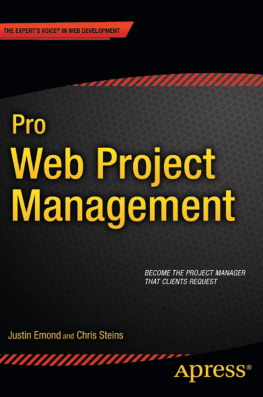
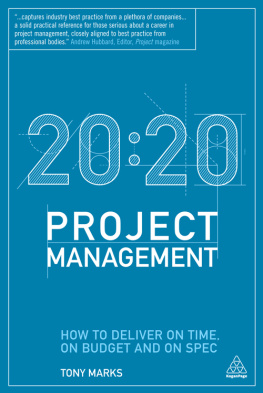
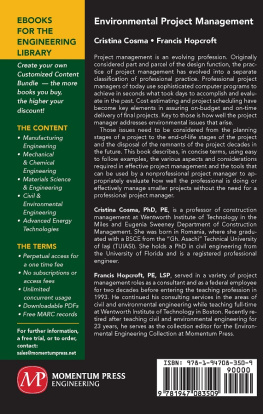
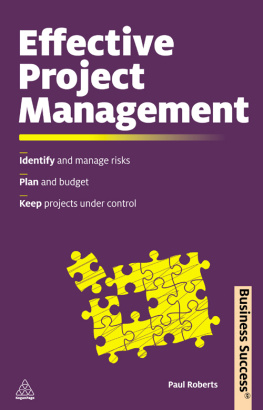
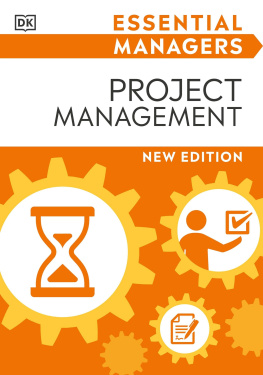
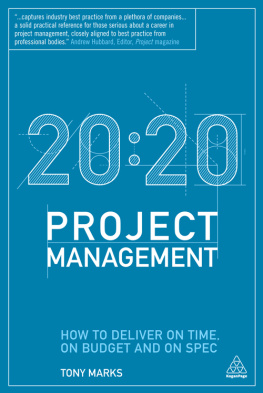




 Justin Emond is a freelance web technology consultant. Justin has worked on both sides of the technology world, in internal technology departments and as an outside consultant delivering services to those on the inside. Prior to being a freelance web technology consultant, Justin was a consultant at Pantheon and a senior project manager at Urban Insight. He has also taught a variety of technology courses at the USC Viterbi School of Engineering, from web programming to project management. He occasionally writes at MissingFeatures.com on topics ranging from usability to interface design to project management. In addition to his work at Urban Insight and Pantheon, Justin created Droptor, a web application that helps teams manage sites powered by the Drupal content management system, and Droptopia, an online visual portfolio of expert Drupal agencies. Justin has a degree in psychology from the University of Southern California, and he regularly reminds Chris that USC is a far better school than UCLA.
Justin Emond is a freelance web technology consultant. Justin has worked on both sides of the technology world, in internal technology departments and as an outside consultant delivering services to those on the inside. Prior to being a freelance web technology consultant, Justin was a consultant at Pantheon and a senior project manager at Urban Insight. He has also taught a variety of technology courses at the USC Viterbi School of Engineering, from web programming to project management. He occasionally writes at MissingFeatures.com on topics ranging from usability to interface design to project management. In addition to his work at Urban Insight and Pantheon, Justin created Droptor, a web application that helps teams manage sites powered by the Drupal content management system, and Droptopia, an online visual portfolio of expert Drupal agencies. Justin has a degree in psychology from the University of Southern California, and he regularly reminds Chris that USC is a far better school than UCLA. Christopher Steins is the chief executive officer of Urban Insight, Inc., a technology consulting firm based in Los Angeles. Chris has a decade of experience in technology consulting and urban planning. He has participated in all aspects of information systems life cycle development, including user requirements, project management, system design, development, and deployment. He has served as a consultant to public sector, state, county, and local agencies, Fortune 500 private firms, educational institutions, and nonprofit organizations. Chris is a lecturer at the University of Southern California, where he teaches a course on technology and public participation in government. Chris received his master's degree in urban planning and development from the USC School of Policy, Planning, and Development, and his bachelor of arts degree in English from the University of California, Los Angeles.
Christopher Steins is the chief executive officer of Urban Insight, Inc., a technology consulting firm based in Los Angeles. Chris has a decade of experience in technology consulting and urban planning. He has participated in all aspects of information systems life cycle development, including user requirements, project management, system design, development, and deployment. He has served as a consultant to public sector, state, county, and local agencies, Fortune 500 private firms, educational institutions, and nonprofit organizations. Chris is a lecturer at the University of Southern California, where he teaches a course on technology and public participation in government. Chris received his master's degree in urban planning and development from the USC School of Policy, Planning, and Development, and his bachelor of arts degree in English from the University of California, Los Angeles.